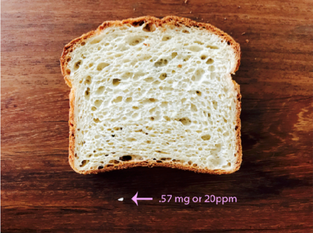 According to the University of Chicago Medicine, one percent of Americans have celiac disease and ninety-seven percent of celiacs in the U.S. are either misdiagnosed or undiagnosed (Celiac). Celiac is an autoimmune disease that can present with over two-hundred symptoms. The Celiac Disease Foundation lists many of these symptoms, such as digestive problems, iron-deficiency anemia, fatigue, arthritis, infertility, depression, anxiety and in severe cases, cancer. Due to the plethora of symptoms that could be indicative of celiac disease, the disease often goes misdiagnosed or undiagnosed (Symptoms). Celiac disease is characterized by an autoimmune reaction to eating gluten, as described by the Mayo Clinic (Mayo). Some examples of gluten-containing grains are wheat, barley, rye, and their derivatives (Sources). Fortunately, there are many gluten-free grains. Individuals with celiac are limited to packaged products containing a maximum of twenty parts per million gluten (Means). In the words of nutritionist Tricia Thompson, “[...] a 1-ounce (28.35 grams) slice of gluten-free bread containing 20 parts per million gluten would contain 0.57 milligrams of gluten (Thompson).” That’s how seriously the gluten-free diet must be taken. Intense, I know. Celiac disease requires a lot of preparation. The only known treatment for celiac is to follow a gluten-free diet for life (Treatment). People with celiac will find that incorporating a strict gluten-free diet into their life can be difficult at first. Don’t be discouraged! Life goes on after celiac. Clinical psychologist Dr. Katie Rickel explains the power of food in our society. “We live in a food-centric society, a culture so obsessed with eating that we incorporate this behaviour in almost every social activity imaginable (Rickel).”  Is it possible to live in the moment with a chronic illness like celiac disease? People with celiac must carefully consider anything that touches their lips or enters their mouths. Celiacs must be weary of the beauty products they use that may enter their mouth, as well as medications (Vann). Celiac is intense! Hang in there, it gets better. Gabriella Lind explains why people should make an effort to live in the moment in her article 7 Reasons Why You Should Live in the Moment. Some of her points are, “Being present results in decreased stress,” and “You will enjoy moments for what they are (Lind).” These are great ideas but when someone is burdened with a strict, mandatory, life-long diet, enjoying a care-free night out can be rather onerous and seemingly impossible. Don’t fret; there’s good news. With the growing number of people diagnosed with celiac every year, the demographic of individuals with the disease is on the rise (Parker). That’s why I decided to reach out to people with celiac disease around the world to get their input on this topic. Here are five tips to live by based on the real life experiences of fellow celiacs, including myself. Don’t leave home hungry. It’s not easy to find gluten-free meals on the road. Finding a snack shouldn’t be too problematic but finding a meal can be challenging. Make sure to leave home feeling full and satisfied. Don’t forget to pack a snack. Whether a person with celiac is going to prom, a wedding or a house party, they should expect that there will be no food for them. They should bring along their favourite gluten-free snack so that they can enjoy themselves like everyone else. Kind bars are a quick fix and they’re easy to transport (KIND). Ashley Gismondi, a Toronto woman living with celiac, knows first-hand what it’s like to be deprived of food for a long period of time. “Always pack your own snacks, you never know when you will get hungry on a road trip or on a plane. There’s been times where my gluten free meals never made it on a plane (Gismondi).” Continue doing all the things. People with celiac shouldn’t miss out on any experiences or opportunities due to their disease. Take Erin Smith for example. Smith, a New York-based individual with celiac was diagnosed at only two years old. Smith never allowed the disease to control her life. She recalls, “I grew up going on family vacations, going to sleepaway camp every summer, went away to college, etc. (Smith).” Surely, these experiences required careful planning, but that didn’t stop her. “I never let celiac stop me. Of course I had to learn new ways to navigate with every new chapter of my life, but I feel like I never let celiac hold me back (Smith).” Don’t live in fear, instead travel everywhere. Smith has visited twenty-three countries, thirty-seven states “and all while living with celiac and eating 100% gluten-free (Smith).” People with celiac should always bring many snacks with them and do research to find gluten-free restaurants in their travel destinations. Gismondi recommends getting “a translated card in the native language to communicate your needs about gluten containing ingredients and the importance of cross contamination (Gismondi).” Find resources that can help you cope, celiac is a slippery slope. Those first few months or even years can be quite challenging. That’s why it’s so important to have a strong support system. Educate your family about your disease, speak to a nutritionist and to your gastroenterologist. Gismondi made a great point in an Email conversation with me. When she said, “Get online and connect with other individuals with Celiac Disease (Gismondi).” This is a fantastic coping strategy that many may not think of. Additionally, your gastroenterologist will likely be glad to refer you to a psychologist who can help you adjust to your new reality. Tarryn Skuy from Toronto was diagnosed with celiac disease at sixteen years old. After living with celiac for almost ten years, she has mastered the disease. Here are some words of wisdom from Skuy. “Over time, I have learned that I can't be scared to get sick in public. It can be avoided, and majority of time it is, but in order to live in the present, you have to be understanding that it could happen, and that is ok, because it's out of your control, it's what Celiac Disease is all about (Skuy).” Life is a gift, with or without celiac. You can still live in the moment and enjoy life with celiac disease. Just remember to plan and prepare for your outings. With these guidelines, nothing should stand in your way. So stick to your diet, pack some snacks and travel the world! Bon appetit! Written By: Chavy Dworkind Works Cited “Celiac Disease Facts and Figures.” The University of Chicago Medicine. Celiac Disease Center. www.cureceliacdisease.org/wp-content/uploads/341_CDCFactSheets8_FactsFigures.pdf. Accessed 24 Mar. 2019. Gismondi, Ashley. “Re: Celiac!” Message to Chavy Dworkind. 24 March 2019. E-mail. “Gluten free.” KIND. www.kindsnacks.com/ways-to-snack/by-benefit/gluten-free/. Accessed 24 Mar. 2019. “‘Gluten-Free’ Means What It Says.” FDA Food & Drug Administration. Consumer Updates. Updated 11 May 2018. www.fda.gov/ForConsumers/ConsumerUpdates/ucm363069.htm. Accessed 24 Mar. 2019. Lind, Gabriella. “7 Reasons Why You Should Live in the Moment.” REACT - What About NOW? Page 4. June 2018. classroom.google.com/u/0/w/MTYyNTUyNjM3MTNa/t/all. Accessed 24 Mar. 2019. Mayo Clinic Staff. “Celiac Disease.” Mayo Clinic. Patient Care & Health Information - Diseases & Conditions. 6 Mar. 2018. www.mayoclinic.org/diseases-conditions/celiac-disease/symptoms-causes/syc-20352220. Accessed 24 Mar. 2019. Parker-Pope, Tara. “Celiac Disease Becoming More Common.” The New York Times. Well. 2 July 2009 11:17 AM. well.blogs.nytimes.com/2009/07/02/celiac-disease-becoming-more-common/. Accessed 24 Mar. 2019. Rickel, Katie. “What role does food play in my social life?” Sharecare. Health Topics - Wellness - Healthy Habits. www.sharecare.com/health/healthy-habits/what-role-food-social-life. Accessed 24 Mar. 2019. Smith, Erin. “Re: Celiac!” Message to Chavy Dworkind. 24 March 2019. E-mail. “Sources of Gluten.” Celiac Disease Foundation. celiac.org/gluten-free-living/what-is-gluten/sources-of-gluten/. Accessed 24 Mar. 2019. “Symptoms of Celiac Disease.” Celiac Disease Foundation. celiac.org/about-celiac-disease/symptoms-of-celiac-disease/. Accessed 24 Mar. 2019. Skuy, Tarryn. “Re: Celiac!” Message to Chavy Dworkind. 24-25 March 2019. E-mail. Thompson, Tricia. “How much gluten is 20 parts per million?” Gluten Free Dietitian. 6 Feb. 2008. www.glutenfreedietitian.com/how-much-gluten-is-20-parts-per-million/. Accessed 24 Mar. 2019. “Treatment of Celiac Disease.” UChicago Medicine. Celiac Disease Center - Education. www.cureceliacdisease.org/treatment/. Accessed 24 Mar. 2019. Vann, Madeline R. “There’s Gluten in That? 13 Surprising Items That Contain Gluten.” Everyday Health. Digestive Health - Celiac Disease. Last updated 20 Nov. 2014. www.everydayhealth.com/digestive-health/0313/surprising-products-that-contain-gluten. aspx. Accessed 24 Mar. 2019.
2 Comments
Aliza D
3/31/2019 09:32:05 pm
What a well written article. Thank you for educating people about celiac! Best of luck xoxo
Reply
Jack D
4/1/2019 08:17:24 am
Hi Chavy, your article was well written, very upbeat and certainly encourages other people with coeliac disease to move forward, live the moment and not let the disease hinder the pursuit and enjoyment of all of life’s wonderful gifts. I felt good after reading your blog because I was able to understand how you cope daily in overcoming your challenges and try to live a normal and productive life as best as you can. Your supportive blog will definitely help other people overcome this condition. Have a wonderful and happy day!! XOZJ.
Reply
Leave a Reply. |
Welcome to MCL World-Featured Bloggers

I created this page to provide the latest content from other gluten-free related bloggers around the world! This page will be a dedicated space for MCL's featured bloggers to offer helpful tips to living a gluten-free life!
Archives
March 2019
Categories |
Want to learn more? send me an email |
|
Copyright © 2018 My Celiac Life. All Rights Reserved.

 RSS Feed
RSS Feed